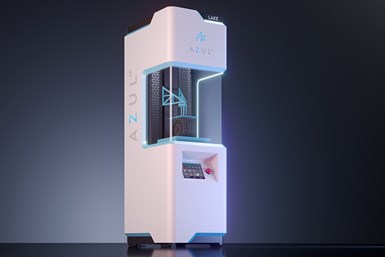Azul 3D’s Lake Printer Enables Mass Manufacturing on Single, Streamlined Platform
Azul 3D can enable manufacturers to transition from prototyping to mass manufacturing on a single, streamlined production platform.
The Lake printer is powered by Azul 3D’s high-area rapid printing (HARP) technology, its version of stereolithographic printing that converts liquid plastic into solid objects using ultraviolet light.
The printer is powered by Azul 3D’s high-area rapid printing (HARP) technology, its version of stereolithographic printing that converts liquid plastic into solid objects using ultraviolet light. The company says the Lake prints complex geometries at rapid speeds, using proprietary materials suited for a wide range of products.
With a print area of 10" × 12" × by 24", the printer’s interface is said to dissipate heat, enabling continuous high-speed printing over large areas. Lake is powered by a custom, high-intensity LED light engine that enables users to address 16 million independent pixels without the need for “pixel shifting” used by other projectors.
Azul 3D was spun out of the Mirkin Research Group at Northwestern University, a lab known for materials science and nanoscience. The company says the printer is bolstered by Azul 3D’s chemistry group, which designs proprietary resins that are strong, durable, customizable and compatible with high throughput printing.
The Lake is said to bring a new level of speed and customization to the industry. At the outset of the COVID-19 pandemic, Azul 3D used the Lake printer to print 5,000 face shields in 60 hours for health care workers. That meant every 6 minutes, Azul 3D was able to get eight face shields off the printer and begin starting the next round of printing.
Azul 3D also partnered with Wilson Sporting Goods to use the Lake to print pickleball paddles that are completely customizable, unlocking new features, including removing dead spots, increasing punch and silencing ball hits.
For manufacturers interested in incorporating 3D printing, Azul 3D says it offers a full-stack solution to partner with them on design, materials, printing and postprocessing to ensure the process is optimized for their factory floor.
Related Content
-
Beehive Industries Is Going Big on Small-Scale Engines Made Through Additive Manufacturing
Backed by decades of experience in both aviation and additive, the company is now laser-focused on a single goal: developing, proving and scaling production of engines providing 5,000 lbs of thrust or less.
-
DMG MORI: Build Plate “Pucks” Cut Postprocessing Time by 80%
For spinal implants and other small 3D printed parts made through laser powder bed fusion, separate clampable units resting within the build plate provide for easy transfer to a CNC lathe.
-
With Electrochemical Additive Manufacturing (ECAM), Cooling Technology Is Advancing by Degrees
San Diego-based Fabric8Labs is applying electroplating chemistries and DLP-style machines to 3D print cold plates for the semiconductor industry in pure copper. These complex geometries combined with the rise of liquid cooling systems promise significant improvements for thermal management.











